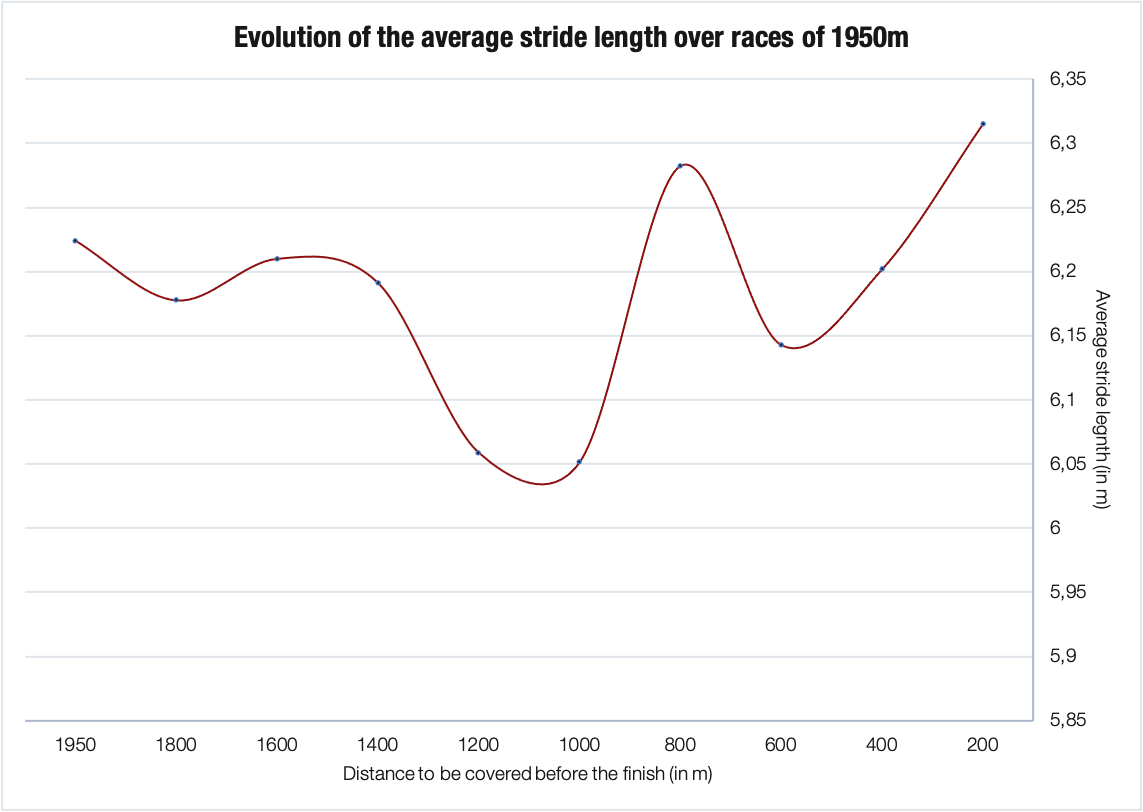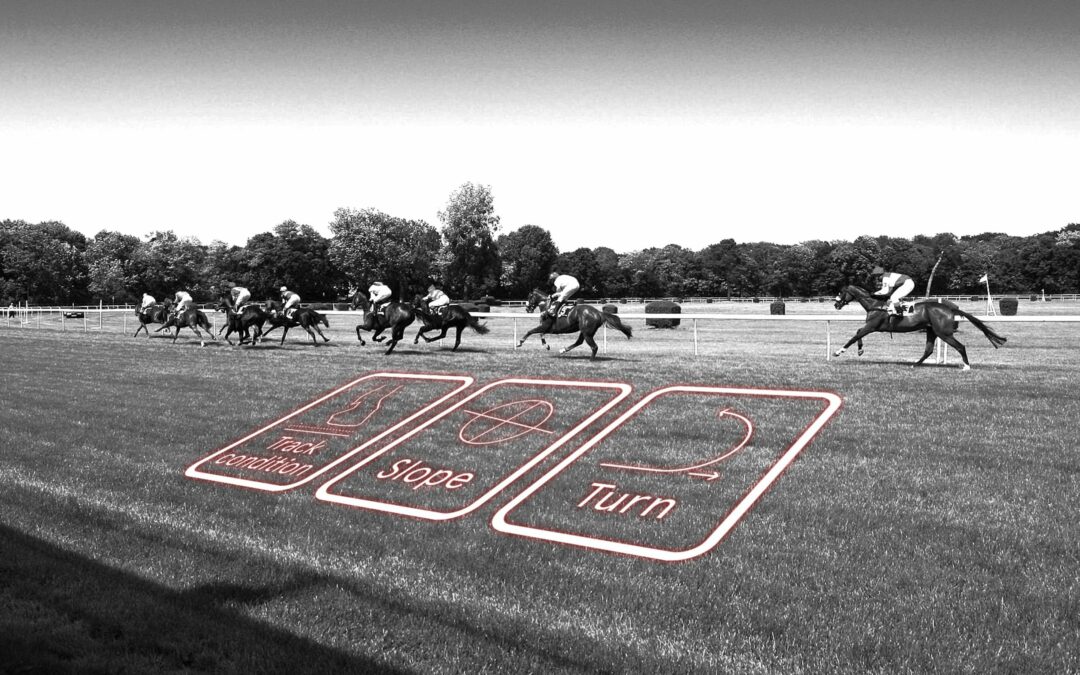The horse’s locomotion is strongly influenced by the track on which he moves. Indeed, the racehorse does not move in the same way on deep ground as on a slope. The quality and the type of track are deciding factors of the speed strategy during a race. This section will evaluate the impact of the turns, the slope and the quality of the ground on the stride length and stride frequency.
1. THE TURNS
Straight and curved work are two different exercises. In a curve, the effort required from the horse is greater than in a straight line. Just like cars, horses are subject to centrifugal force pulling them out of the curve. In order to stay inside the bend and not lose time, the horse has to put in more effort. In order to recover his natural balance, the horse adapts his locomotion, which explains why the effort is of a more intense nature.
Why do curves imply a change in locomotion? How are stride length and stride frequency affected? Should curve training be encouraged?
Restoration of the natural balance
The centrifugal force disturbs the horses’ balance during turns. To avoid slipping, especially on hard ground, horses have to change their locomotion. The inside front end is subjected to higher pressure than the outside front end. The muscles on the interior side of the horse are put under great strain to avoid the horse to collapse (Cogger et al., 2006).
Speed reduction
The speed in the race tends to decrease during the turns (Rooney, 1983). Indeed, horses are forced to slow down in order to stay in the race for a longer period of time as they have to put in more effort during the turns. The stride length decreases sharply while the drop-in pace is much lighter. As the muscles are subjected to greater effort, they are no longer strong enough to maintain a stride length equal to the one of a straight line.
Let’s take a concrete example from a 1950m trot race. What was the variation in pace and length?
In the following graph, the average of 21 races was achieved over 200m sections. For each turn, there was a decrease in length, especially in the tightest turn.
The introduction of curve work in training then appears relevant. This enables the development of specific muscles and trains the horse to adapt his locomotion in order to improve his mobility. This is even more important for trotters. Indeed, young horses must learn to manage the movement of their limbs to not touch each other (this would risk putting them at fault).

2. THE SLOPE
Whether at the hippodrome or on the training tracks, there is always a more or less marked difference in height. Why does the horse adapt his locomotion to the slopes? How is this change perceived in the data? Is hill training beneficial for horses?
Whether uphill or downhill, slopes necessarily induce a change in movement.
Ascending slope
On an uphill track, the effort required of the horse is greater than on a flat track: he must overcome the gravity which tends to prevent his progression. The steeper the slope, the more intense the effort will be. Slopes induce changes in locomotion. Stride length decreases sharply due to the additional force required to cover the same distance as on the flat. On the one hand, if the horse expends the same amount of energy, his stride length and stride frequency will drop on the uphill. On the other hand, if the horse has to accelerate uphill, he only increases his pace (his stride length does not change).
Hill training has several benefits. Uphill training allows the horse to work at maximum effort without reaching his maximum speed. Because of the strength required for progression, it allows the horse to develop power as well as musculature.
Downhill slope
During a downhill slope, the main challenge is to control the balance. This is difficult because to be efficient, racehorses put a lot of weight on their forehand which is then very overloaded during the descents.
Downhill training is not necessarily recommended as no demonstration has been made on this type of work. Some scientists hypothesize that such training could lead to injury.
In the following example, the exercise starts on a downhill slope, continues on a false flat before ending on an uphill slope. The horses have been asked to speed up on the uphill slope. Horses reach their maximum stride length on the false flat at the end of the descent. However, they are forced to reduce it during the ascent due to the strain on the muscles. Thanks to the increase in their pace, they are able to accelerate slightly.
This example highlights the fact that neither horse is able to maintain his stride length during a climb. Concerning the pace, if they are both able to increase it in order to accelerate during the uphill, the descent can prove to be complicated to handle. The data shows that the horse n°1 decreases his pace in order to restore his balance.
It is possible to explain that the stride length continues to decrease even though the slope is gentler (going from 8.6 to 6.4%) by a “fatigue effect”: the muscles put to the test during the shift to 8% need a little more time before they are able to function normally.


3. THE FIELD
Turns and slopes are factors influencing the speed and locomotion of racehorses. However, we must add the influence of the ground on which the horse moves. In Europe horses run mainly on grass or synthetic tracks. They can also run on sand during training. What are the characteristics of the different tracks? Why does the horse’s locomotion change depending on the surface? How do the length and pace vary according to the type of ground?
The grass slopes depend on the weather. Temperature and precipitation strongly influence their quality. When the circumstances are optimal, they provide good stride absorption, short laying times and remarkable speed peaks. Synthetic tracks allow them to be relatively independent of the weather, although slight variations do exist. However, their quality is far from equal to that of natural tracks.
On the very hard tracks, the propulsion of the horse is excellent with a minimum loss of energy. The strides have a great length and the increase in pace is simplified. Nevertheless, hard tracks do not always allow the highest speeds. Indeed, the impacts are not cushioned and this can be painful for the horses. However, the progression on a deep track is very complicated. The speed is then reduced because horses reduce their pace and length.
The type of ground on which the horse moves influences not only his speed but also his locomotion. Generally speaking, at a constant speed, the harder the ground, the longer the strides will be and, on the contrary, the deeper the ground, the shorter the stride.


This chart shows the average stride frequency and stride length of galloping horses as a function of the depth of grass tracks. The stride frequency and stride length are therefore correlated to the quality of the track. Both frequency and length decrease as the depth increases: horses run slower in the mud than on very hard ground (source: English racing database).
Here we find the grass races at full gallop. Depending on the quality of the ground, you can see the average pace and length of the horses finishing in the first 3 at 60km/h. This allows us to compare the locomotion at the same speed, which gives us indications that the horses move preferentially on these types of track. In deeper ground, horses tend to make strides of shorter duration. This enables them to limit the risk of slipping and the effort required to pull themselves out of the ground before the suspension time. On the contrary, in harder ground, the horses take longer strides. (Source: English racing database)
Key words: racehorse locomotion, racehorse track, racehorse speed, amplitude, cadence, centrifugal force, hippodrome, ascending and descending slopes, racehorse maximum speed
Bibliography:
Cogger, N., Perkins, N., Hodgson, D., Reid, S. and Evans, D., 2006. Risk factors for musculoskeletal injuries in 2-year-old Thoroughbred racehorses. Preventive Veterinary Telemedecine, 74, pp.36-43. In text : (Cogger et al., 2006)
Rooney, J., 1983. Impulse and breakdown on straights and turns in racehorses. Journal of Equine Veterinary Science, 3(4), pp.137-139.

